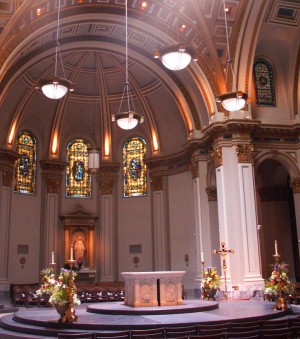(One of the goals of Brothers of John the Steadfast is to train the Brothers in good practice and theology. This article is one in a series that teaches about the liturgy.
These articles were initially intended to be put into bulletins or read during the service to educate the laity on the different parts of the service. They were therefore purposefully made short.
Notes on the Liturgy #8 — Collect
 The Collect is a prayer that often focuses on the content of the Gospel or Epistle reading. It is part of the propers of the day that start on pg. 10 of “Lutheran Worship”. (For the Lutheran Service Book, these are found in the Altar Book.) Since it is a “proper” it means it changes from Sunday to Sunday just like the Introit. The prayer is “proper” for a particular Sunday. Thus, it aids in the unity of thought in the service. MOST IMPORTANTLY, like all other liturgical elements, the Collect serves the Gospel and glorifies the Lord by focusing our faith outwardly on the presence and promises of God! This is a great strength of liturgical worship over against emotion based, charismatic style praise services that often focuses one inward. If emotion become too much a focus, it obscures what God has said and done for us.
The Collect is a prayer that often focuses on the content of the Gospel or Epistle reading. It is part of the propers of the day that start on pg. 10 of “Lutheran Worship”. (For the Lutheran Service Book, these are found in the Altar Book.) Since it is a “proper” it means it changes from Sunday to Sunday just like the Introit. The prayer is “proper” for a particular Sunday. Thus, it aids in the unity of thought in the service. MOST IMPORTANTLY, like all other liturgical elements, the Collect serves the Gospel and glorifies the Lord by focusing our faith outwardly on the presence and promises of God! This is a great strength of liturgical worship over against emotion based, charismatic style praise services that often focuses one inward. If emotion become too much a focus, it obscures what God has said and done for us.
The Collect is somewhat poetic and reverent in nature. It is not written/spoken in a free, extemporaneous style. Yet, we should never fall into the mistaken notion that written prayers are not spiritual. On the contrary, a written prayer is well thought out reflection of the God of order. It has been said of the Collect, “Their humility of spirit is balanced by certainty of faith, and their brevity of form by breadth of thought.” (L. Reed, The Lutheran Liturgy) Both written and extemporaneous prayers have a place among God’s people as long as the prayer is truly spiritual in the thought it conveys and in the heart of faith that prays it.
The Collect will often follow this five part pattern. The example comes from pg 52 of Lutheran Worship:
- God is addressed. Typically it is the Father, but prayers addressed to the Son and Holy Spirit are also used when it is appropriate (e.g. “Almighty God, merciful Father”)
- The basis of the prayer is given (e.g. “since you have awakened from death the Shepherd of your sheep”)
- The request is given (e.g. “grant us your Spirit that we may know the voice of our Shepherd”)
- The purpose or benefit of the prayer (e.g. “that sin and death may never pluck us out of your hand”)
- The ending which is a doxology and serves to clarify once again that we are praying to the one and only Triune God (e.g. “through Jesus Christ, our Lord, who lives and reigns with you and the Holy Spirit, one God, now and forever.”)
Previous Notes on the Liturgy —
Introduction
Invocation
Confession
Absolution
Introit, Psalm or Hymn
Kyrie and Gloria
Salutation
Collect
You may find all these by looking at our Regular Column on the Explanation of the Divine Service category or by using the shortcut https://steadfastlutherans.org/liturgy.
These notes were originally written in 2001 by Pastor David Oberdieck and have been edited. Thanks to Pastor Mathey for improvements to this segment.